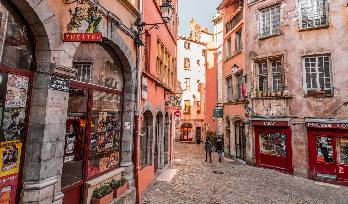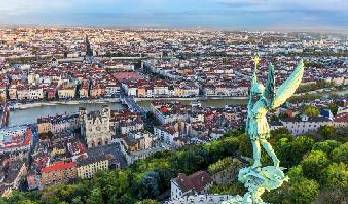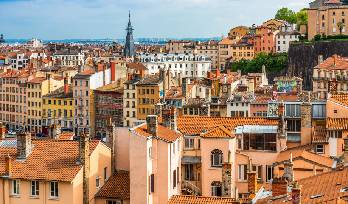With more than 2,000 years of history, the city of Lyon has been shaped by the passing of time, leaving today's visitor with neighborhoods with a unique atmosphere that bear witness to the city's evolution. Since its foundation by the Romans in 43 BC on the hill of Fourvière, the city has expanded from west to east, taking advantage of its two hills and two rivers.
Listed as a UNESCO World Heritage Site in 1998, Lyon's 4 historic districts cover 500 hectares and will take you on a journey back in time. Follow the guide, from Antiquity to the present day!

Vieux Lyon: Between Fourvière Hill and the Saône River
Vieux-Lyon has retained all the charm of its Renaissance streets. This historic district is a true architectural gem. Secret and mysterious, Vieux-Lyon can be discovered behind doors, where traboules (hidden passageways linking two streets by passing through the interior of a building) and interior courtyards reveal all the wealth of their former owners. Around the Gothic Saint-Jean cathedral, Rue Saint-Jean is home to restaurants and stores. On Rue du Bœuf, designer boutiques alternate with Lyonnais bouchons and Michelin-starred restaurants. Don't hesitate to get lost in the cobbled streets of the district!

The Presqu'île : The heart of Lyon beats between the Rhône and Saône rivers
The Presqu'île also offers superb strolls along the riverbanks, where you can stroll, cycle or picnic while enjoying the view of the city. You can stroll, cycle or picnic while enjoying the view over the city. At nightfall, fountains and emblematic monuments are illuminated for a rediscovery of Lyon in light. Summer evenings are particularly lively, with ephemeral bars and open-air concerts.

Fourvière: Lyon's oldest hill
Fourvière preserves the remains of Lugdunum, capital of Gaul under the Roman Empire. Two ancient theaters are reminders of Lyon's early days: the grand theater, built in the 1st century BC and enlarged in the 1st century AD, was dedicated to theater and could accommodate up to 10,000 spectators. The small theater, called the Odeon, was built in the 1st century AD and hosted public readings and recitals. Adjacent, the Musée Lugdunum showcases Lyon's archaeological discoveries. Because in Lyon, as soon as you dig in the ground, you find remains! At the top of the hill, the Fourvière basilica is a symbol of Lyon. Its impressive architecture and colorful mosaics are well worth a visit. What's more, you can enjoy a breathtaking view of the whole city from the basilica.

La Croix-Rousse: Lyon's second hill
presents visitors with its astonishing allure, with its buildings tiered along the hillside. Since the 19th century, the Croix-Rousse has been known as "the hill that works", as opposed to Fourvière, "the hill that prays". As Lyon's silk district, it resounded in the 19th century to the sound of the "Bistanclaques", the nickname given to the weaving looms by the Lyonnais.
30,000 canuts (the name given to silk workers in Lyon) brought the district to life, establishing Lyon as a major textile center in Europe. Les Pentes retains a genuine neighborhood life and village spirit, making its inhabitants very proud to be croix-roussiens.
Known as the capital of gastronomy, Lyon offers a multitude of delicious culinary specialties. Don't miss out on famous regional dishes such as quenelle, andouillette, gratin dauphinois and tarte aux pralines. The many bouchons lyonnais, small typical restaurants, will allow you to sample these local delicacies.

Contact us today to create a tailor-made itinerary in the Lyon region, where history, culture and beauty combine for an unforgettable experience.
We take care of every detail to make your trip memorable.
Contact Karine : karine@grouptour.fr